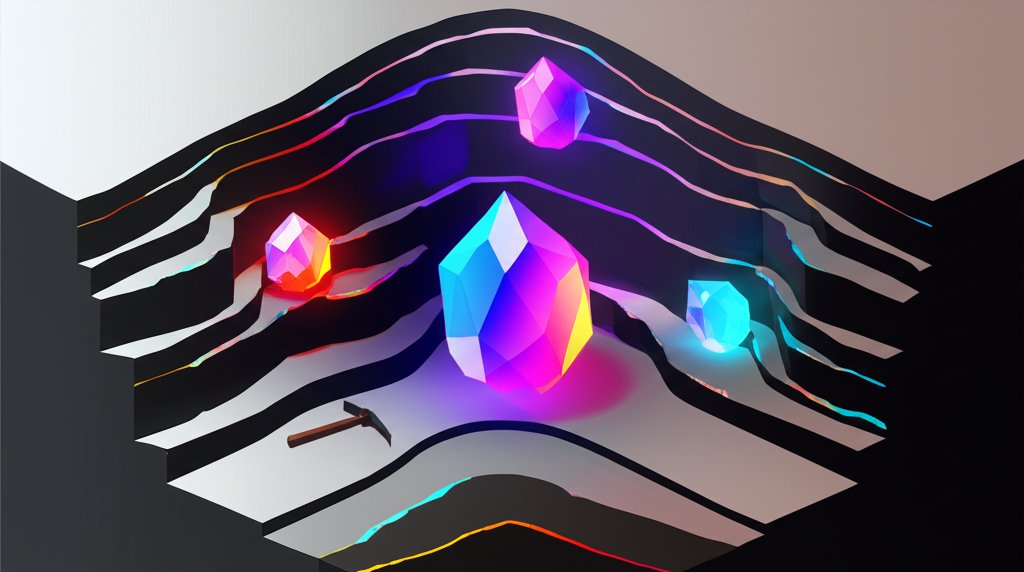Welcome, fellow enthusiasts, to an extraordinary journey into the hidden corners of the Earth, where nature’s artistry takes on its most peculiar and dazzling forms. Forget the familiar sparkle of diamonds and the classic allure of sapphires; today, we’re diving headfirst into a world less seen. Prepare to be utterly captivated as we unveil a treasure trove of bizarre gemstone trivia, explore the astounding realm of rare gemstones, and reveal the most unusual gemstones that defy conventional beauty. This isn’t just a list; it’s an adventure into the very heart of gemology trivia, promising to leave you astonished by the wonders that lie beneath our feet.
The Unseen Wonders: What Makes a Gemstone Bizarre or Unusual?

What exactly makes a gemstone “bizarre” or “unusual”? It’s more than just scarcity; it’s about defying expectations. It could be an inexplicable color, an uncanny optical effect, a formation process unlike any other, or a history steeped in strange tales. These are the gems that make even seasoned gemologists raise an eyebrow in fascination.
If you’re eager to expand your knowledge of these geological marvels even further, you might be surprised by these fun facts about gemstones and their fascinating properties.
Beyond the Big Four: Defining ‘Bizarre’
While diamonds, rubies, emeralds, and sapphires reign supreme in popularity, their very ubiquity means they seldom venture into the realm of the truly bizarre. The term “bizarre” in gemology often refers to extreme rarity, unique chemical compositions, complex growth patterns, or optical properties that seem almost magical. Think gems that change color dramatically, ones that glow in the dark, or those formed in conditions so extreme they challenge our understanding of geology.
Nature’s Oddities: Formation & Phenomena
Most gemstones crystallize deep within the Earth’s crust under immense heat and pressure. However, some unusual gemstones arise from truly bizarre circumstances. Consider organic gems like pearls or amber, formed by living organisms. Then there are impactites, created from meteorite strikes, or even gems that arrive on Earth from space! These extraordinary origins contribute significantly to their bizarre gemstone trivia status. The sheer range of conditions under which these treasures form is a testament to Earth’s dynamic and often unpredictable nature.
Optical Illusions & Unique Inclusions
Part of the intrigue of unusual gemstones often lies in their visual effects. Phenomena like asterism (a star-like effect), chatoyancy (the “cat’s eye” effect), or pleochroism (displaying different colors from different angles) are stunning. But some gems take it a step further. Imagine a gemstone with perfectly preserved ancient organisms, or one that changes color not just subtly, but entirely, from blue to red depending on the light source. These optical dances and captivating inclusions are prime examples of bizarre gemstone trivia in action, turning a simple mineral into a living work of art.
Unearthing the Earth’s Most Rare Gemstones
While many gems are beautiful, only a select few are truly rare. These are the elusive treasures that gem collectors dream of, found in only one or two locations worldwide, often in minuscule quantities. Their scarcity alone makes them a focal point for bizarre gemstone trivia.
Painite: The World’s Rarest Mineral?
Discovered in Myanmar in the 1950s by British gemologist Arthur Charles Davy Pain, Painite was once considered the rarest mineral on Earth. For decades, only two faceted specimens were known to exist. This incredibly rare gemstone is a rich brownish-red to orange-red and contains calcium, zirconium, boron, aluminum, and oxygen. Imagine the excitement and the sheer historical significance of finding such a unique mineral, a truly captivating piece of gemology trivia. While new deposits have been found since its initial discovery, Painite remains exceedingly rare and highly sought after by collectors for its history and beauty.
Taaffeite: A Serendipitous Discovery
The story of Taaffeite is pure bizarre gemstone trivia. In 1945, Irish gemologist Richard Taaffe bought a box of what he believed were cut spinels. Upon closer inspection, he noticed unusual double refraction in one of the stones, realizing it was an entirely new mineral. This marked the first time a gemstone was identified from an already faceted stone rather than a rough specimen. Taaffeite, found primarily in Sri Lanka and Tanzania, ranges from colorless to lavender, and is considerably rarer than diamond. Its accidental discovery makes it one of the most intriguing unusual gemstones.
Alexandrite: The Color-Changing Marvel
Often described as “emerald by day, ruby by night,” Alexandrite is one of the most mesmerizing rare gemstones due to its dramatic color-change property (pleochroism). Under natural daylight, it appears emerald green, while under incandescent light, it transforms into a stunning purplish-red. This incredible phenomenon is due to the presence of chromium and the way the stone absorbs and reflects light. First discovered in Russia’s Ural Mountains in 1830 on the day future Tsar Alexander II came of age, Alexandrite’s rarity and magical transformation make it a prized specimen and an excellent piece of gemstone trivia. Good quality, naturally occurring Alexandrite is exceptionally rare today.
Red Beryl (Bixbite): A Crimson Rarity
Found almost exclusively in the Wah Wah Mountains of Utah, Red Beryl is an astonishingly rare gemstone, often called “red emerald.” It’s estimated to be 8,000 times rarer than emerald and 1,000 times rarer than diamonds. Its vibrant crimson hue is a sight to behold, but its crystals are typically very small, and facet-grade material is incredibly scarce. Mining for Red Beryl is extremely difficult, adding to its allure and making it a significant piece of bizarre gemstone trivia for collectors.
Grandidierite: The Blue-Green Enigma
Discovered in Madagascar in 1902 and named after French explorer Alfred Grandidier, this exquisite gem displays a unique blue-green to greenish-blue color. Grandidierite is another exceptionally rare gemstone, characterized by its trichroic properties, meaning it shows three different colors (dark blue-green, colorless, or dark green) depending on the viewing angle. Its elusive nature and stunning color palette make it a fascinating subject for any discussion about unusual gemstones. A significant find in southern Madagascar in 2000 brought more specimens to light, but it remains highly valued.
Jeremejevite: Beyond the Familiar Palette
Often found as small, extremely clean, light blue to colorless crystals, Jeremejevite is a borate mineral initially discovered in Siberia in the late 19th century. High-quality faceted Jeremejevite is among the rarest gemstones on Earth. Its simple yet captivating beauty, coupled with its extreme scarcity, places it firmly in the category of unusual gemstones that push the boundaries of conventional gem appreciation. Its name, another obscure piece of gemology trivia, honors Russian mineralogist Pavel Jeremejev.
Musgravite: Cousins of Taaffeite
Discovered in Australia’s Musgrave Ranges in 1967, Musgravite is chemically related to Taaffeite and equally, if not more, rare. For many years, only a handful of specimens existed. This extremely rare gemstone ranges from translucent grey to purple-green and commands exceptionally high prices due to its scarcity. Identifying Musgravite often requires advanced gemological testing to distinguish it from its Taaffeite brethren – a true challenge even for the most experienced gemologists, adding to its bizarre gemstone trivia.
Jadeite: More Than Just Green
While “jade” often conjures images of beautiful green carvings, the rare gemstone known as Jadeite is far more diverse and can be incredibly valuable. The most prized variety is Imperial Jade, a vibrant, translucent emerald green. However, Jadeite also comes in lavender, yellow, pink, and even black, with some colors being exceptionally rare. Its incredible toughness and historical significance, particularly in Mesoamerican and East Asian cultures, makes it a rich subject for gemstone trivia, especially when considering its less common hues.
Benitotite: California’s State Gem
Discovered in California in 1907, Benitotite is a strikingly beautiful blue to violet-blue gemstone, notable for its strong dispersion, giving it a fire similar to diamonds. Aside from its unique color, its most startling characteristic is its strong fluorescence under UV light, glowing a bright blue-white. This unusual gemstone is found almost exclusively in the San Benito County, California, making it not only incredibly rare but also geographically specific, a true point of bizarre gemstone trivia.
Poudretteite: A Pink Perfection
First discovered in the 1960s in Mont Saint-Hilaire, Quebec, Canada, Poudretteite typically forms as small, colorless crystals. However, a single, magnificent, highly saturated pink crystal was found in Mogok, Myanmar in 2000, creating an unprecedented stir in the gem world. This virtually unknown gem instantly became one of the most rare gemstones, prized for its stunning color and minuscule global supply. The discovery of this perfect pink specimen is a modern highlight of gemstone trivia.
Black Opal: The Fire Down Under
While opals are known for their play-of-color, Black Opal from Lightning Ridge, Australia, takes the trophy for being the rarest and most valuable form of opal. Its dark body tone provides a dramatic contrast for the vibrant spectrum of colors that flash across its surface. The intensity and range of colors, from fiery reds to electric blues, against the dark background are simply unparalleled, making it one of the most unusual gemstones and a testament to nature’s extraordinary palette. The hunt for these elusive “lights of the desert” is legendary in gemology trivia.
Delving Deeper: Fascinating Gemology Trivia & Scientific Oddities
Beyond their visual appeal, gemstones offer a window into complex geological processes, quantum mechanics, and even cosmic events. Gemology trivia reveals the science and stories behind the shine.
Gemstones from Space: Pallasite Peridot
Talk about bizarre gemstone trivia! Not all gemstones are formed on Earth. Pallasite meteorites, originating from the asteroid belt, contain striking translucent olive-green crystals of peridot (olivine) embedded within an iron-nickel matrix. These extraterrestrial peridots, literally falling from the sky, are a stark reminder that the universe holds even more dazzling secrets than our own planet. Collecting and cutting these “space gems” presents unique challenges for gemologists.
Living Gems: Pearls, Amber, and Ammolite
While most gems are minerals, a select few are organic, meaning they’re formed by living organisms.
The Mystery of Luminescence: Fluorescent and Phosphorescent Gems
Some gemstones exhibit a captivating phenomenon known as luminescence, where they emit light when exposed to certain types of energy, like ultraviolet (UV) light.
The Enigma of Asterism and Chatoyancy
These optical effects are more than just pretty; they are complex interactions of light with perfectly aligned fibrous inclusions within the gem.
Phantom Quartz and Other Inclusions That Tell a Story
While some inclusions can diminish a gem’s value, others enhance it, turning ordinary crystals into unusual gemstones with stories to tell.
Gemstone Dating: Unlocking Ancient Secrets
Modern gemology trivia extends to sophisticated scientific techniques that can date the formation of gemstones, providing insights into Earth’s geological past. By analyzing the decay of radioactive isotopes within a gem, scientists can pinpoint its age, often to millions or even billions of years. This allows gemologists to verify origins, distinguish natural from synthetic stones, and even contribute to our understanding of ancient tectonic plate movements and volcanic activity. When you hold an exceptionally old gem, you’re literally holding a tangible piece of Earth’s deep history, a true geological time capsule.
Historical Oddities & Lesser-Known Gemstone Trivia

Throughout history, gemstones haven’t just been admired for beauty; they’ve been steeped in folklore, used in unusual ways, and sometimes even become protagonists in tales of curses and intrigue.
The Cursed Diamonds: Hope and Koh-i-Noor
For centuries, tales of “cursed” jewels have fueled bizarre gemstone trivia. The most famous is perhaps the Hope Diamond, a magnificent deep blue diamond with a history of misfortune befalling its owners, from royalty to wealthy socialites. Likewise, the Koh-i-Noor Diamond, now part of the British Crown Jewels, carries a legend of bringing bad luck or death to any male owner. While scientifically debunked, these enduring legends add a captivating, eerie dimension to these priceless rare gemstones, demonstrating humanity’s deep-seated fascination with the supernatural power of gems.
Unusual Ancient Uses: Gems as Medicine or Talismans
Before modern medicine, many cultures believed gemstones possessed potent healing or protective powers. This is a rich source of gemstone trivia.
These aren’t just decorative items; they were integral to ancient spiritual and medicinal practices, making them truly unusual gemstones in their historical context.
Gems That Don’t Fit In: “Semi-Precious” Misconceptions and Underrated Beauties
The distinction between “precious” (diamond, ruby, emerald, sapphire) and “semi-precious” is largely outdated and misleading. Many so-called “semi-precious” stones are incredibly rare gemstones and can be far more valuable than a low-quality precious gem.
This highlights a crucial piece of gemstone trivia: value is determined by quality, rarity, and demand, not by an arbitrary historical classification. Many of these “semi-precious” gems offer significantly more visual intrigue and color variety than the “precious” four.
The “Fake” or Enhanced Gems That Fooled Experts
The world of gemology is also filled with instances of human intervention, sometimes for enhancement, and sometimes for outright deception. This adds another layer to bizarre gemstone trivia.
Collecting Bizarre & Unusual Gemstones: A Guide for Enthusiasts
For those captivated by the unique and the rare, collecting bizarre gemstone trivia isn’t just a hobby; it’s a passion. But how does one navigate this specialized world?
What to Look For: Rarity vs. Aesthetic Appeal
When collecting rare gemstones and unusual gemstones, it’s crucial to balance absolute rarity with personal aesthetic appeal. A gem might be astronomically rare, but if it lacks visual appeal to you, its intrinsic value as a collectible is diminished.
Verifying Authenticity: The Gemologist’s Role
Given the high value and scarcity of rare gemstones, authentication by a certified gemological laboratory is indispensable. An independent lab report (from GIA, GRS, SSEF, etc.) provides objective classification, identifies treatments, and often confirms origin. This is where the deep knowledge of gemology trivia comes into play, as expert gemologists use advanced tools and techniques to identify and distinguish these unique treasures from imitations or similar-looking stones. Never invest in a significant rare gem without proper certification.
The Thrill of the Hunt: Where to Find Them
Finding unusual gemstones and rare gemstones requires patience and research.
Conclusion
Our voyage through the captivating and often perplexing world of gemstones has revealed that beauty truly lies far beyond the conventional. From the mind-bending optical illusions to the miraculous formation stories, the realm of bizarre gemstone trivia is an endless source of wonder. We’ve unearthed some of the Earth’s most rare gemstones and explored the most unusual gemstones, each a testament to nature’s boundless creativity and geological power.
The intricate details of gemology trivia not only illuminate the science behind these marvels but also connect us to ancient cultures, enduring legends, and the thrill of discovery itself. So, whether you’re a seasoned collector or a curious newcomer, we hope this journey has ignited your passion for the extraordinary. Keep exploring, keep learning, and remember that deep within the Earth, and often hiding in plain sight, are countless more shocking secrets waiting to be revealed. Embrace the enchantment, appreciate the rarity, and let the wonders of these unique treasures continue to amaze!
FAQ
Q: How are gemstones classified as “bizarre” or “unusual”?
A: Gemstones are considered “bizarre” or “unusual” due to extreme rarity, unique chemical compositions, complex or unconventional formation processes (e.g., organic, extraterrestrial), or extraordinary optical properties like dramatic color change, intense fluorescence, or unique patterns that defy typical gemstone characteristics.
Q: What is the rarest gemstone ever discovered?
A: While new discoveries can change rankings, Painite was long considered the rarest mineral on Earth, with only a few known faceted specimens for decades. Although more deposits have been found, it remains one of the absolute rarest and most sought-after gemstones. Other contenders include Taaffeite and Red Beryl.
Q: Can gemstones really change color?
A: Yes, absolutely! This phenomenon is known as the “alexandrite effect” or color change. Alexandrite is the most famous example, appearing green in daylight and purplish-red under incandescent light. This is due to the stone’s unique atomic structure and how it absorbs and reflects different wavelengths of light depending on the light source.
Q: Are there gemstones not found on Earth?
A: Yes. Peridot crystals found embedded in Pallasite meteorites are an example of gemstones that originate from space. These extraterrestrial peridots offer a unique connection to the wider cosmos and are a fascinating piece of gemology trivia.
Q: What is gemology trivia?
A: Gemology trivia refers to fascinating and often surprising facts about the scientific study of gemstones. This includes details about their formation, geological origins, unique physical and optical properties, methods of identification, historical significance, and rare or unusual characteristics that intrigue both scientists and enthusiasts.
Q: How can I identify a rare gemstone?
A: Identifying a rare gemstone typically requires the expertise of a certified gemologist and specialized equipment. Key indicators include unique physical properties (like specific gravity, refractive index), distinct chemical composition, characteristic inclusions, and optical effects not seen in common gems. For expensive or significant pieces, an independent gemological laboratory report from a reputable institution (like GIA or GRS) is crucial for accurate identification and authentication.










